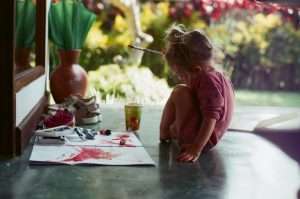Have you ever looked at a piece of art and wondered how to find the best arrangement for it? Why is the top of your refrigerator covered in drawings and paintings? How do you arrange your child’s art so it pleases you, your spouse, and your children? Here are some tips.
While there is no wrong way to display your child’s art in your home, there are definitely some better ways than others. Arranging a collection of art is a lot like choosing what clothes to wear. Everyone has his or her own style. The goal is to show off the art, not hide it. The best arrangements will highlight your child’s work; even if it’s ugly, that’s OK. You want to make everything visible, including the bad ones.
In every house, there are two kinds of pieces: good ones and bad ones. The good pieces are the ones you enjoy looking at. They are scattered around the house, displayed either alone or alongside other good pieces from different periods in your child’s life. This is what people mean when they say “I have my son’s artwork hanging all over my house.” These are the pieces that bring real joy into your life. They can be displayed
In addition to being a great way to display your child’s art, this method can also be used to help teach your child the value of giving and sharing.
There are many different ways to display your child’s art around the house. One popular option is to have a small piece of artwork displayed in every room of the house. This way, everybody gets a chance to appreciate their young artist’s work.
But if your home is small or you don’t want all of their art on display at all times, there are other options. For example, one parent suggests keeping a large collection of smaller pieces displayed in a designated area, such as the kitchen.
Another option is to keep larger pieces up in prominent places throughout the house and then rotate smaller pieces into areas where temporary art displays are desired. For example, parents might keep a number of smaller pieces displayed on shelves in the kitchen for two weeks and then switch them out for another set of small works that remain on display for two more weeks before being replaced by yet another set of small works from their child’s collection.
Whichever method you choose, just remember that it is your choice and you should do what works best for you and your family. Just remember
What does one do with the artwork of their child? Many parents are unsure about this because it seems such a daunting task. How can one possibly display all of these paintings by one’s young artist? The following is an attempt to ease this burden.
First, find a location for the art. The best place is generally the refrigerator. This will allow the child to see his or her work every day and this will let them know that you appreciate their art and care about them.
Second, make sure that there is enough space on the refrigerator to accommodate all of the art your child has done. It is important to create a gallery where each piece can be displayed in a prominent position that allows it to be seen easily by everyone who comes into your house.
The next step is deciding where to put each piece of art. Generally, they should be hung randomly around the house, especially in areas where people will look at them frequently, like above beds and sofas. This shows that you believe that your child’s work is valuable and should be seen by many people. The exception here is that drawings made when the artist was very young should be put in a special place like in a frame and hung up somewhere that only you can see it so that you remember how
Art is best introduced to children through real art—that is, the kind that people make. But how can you get your own artwork out of storage and onto the walls? How do you balance their desire for a show of their own stuff with a place for other art? How do you preserve their sense of ownership when it’s so easy for them to change?
Artwork belongs on the wall. It belongs in a frame, no matter how messy or imperfect. Leave space between pieces so that each one has a chance to stand out. (If you insist on putting them in rows, leave space between those rows, too.) If they want to fill all the space, let them have all the space.
Maintain some balance between their work and art that came later. For instance, if they like their child self-portraits in the bathroom but aren’t thrilled with the other pictures there, consider rotating them so that they come back into rotation again in five years or so. Make sure there’s room for new work.
Don’t arrange everything neatly by age or size; instead, organize according to what communicates best. If you need an organizational device—say, if you have no idea where to put some drawings but
First, the easy part: Posting your child’s artwork.
If you have a child in elementary school, you are probably amply supplied with small pieces of art. This is the time to take advantage of that: Get a stack of 3×5 cards and write down one piece of artwork on each card. Then arrange these cards on your refrigerator, or a bulletin board, or wherever you might display artwork in an office. (A “Welcome” mat is also an excellent place for your child’s work.)
When you run out of space, repeat the process.**
Art is a very important part of your child’s development. It is important that you know how to create the right environment for them to grow artistically. The right environment can make all of the difference between an amazing artist and a mediocre one.
In order to display your child’s art properly, you will need:
Art is the most inclusive art form. It is not the only art form that can be used to express emotions and feelings, but it is certainly the most flexible. Any object may be used as a medium to create art, even though some materials work better than others. So why should you only allow your child to draw with crayons or markers? If you want your child to learn how to make masterpieces, you must provide them with all of the tools they need to accomplish this goal. Why should they use only crayons when they could be using pastels or oil paints instead?
To begin understanding this complex issue, we must first try to understand what part of art is innate and what part of it comes from practice. Almost every aspect of drawing and painting comes from practice, including color mixing, perspective, proportion and shading. But these are all skills that can be learned if you start young enough! Anyone can learn these things as long as you give them time in which to practice them. Art does not come from some natural talent; it comes from learning how to express yourself in this way.
If you want your children to grow up with a strong foundation in art, then you will have to start them at an early age. It is never too


